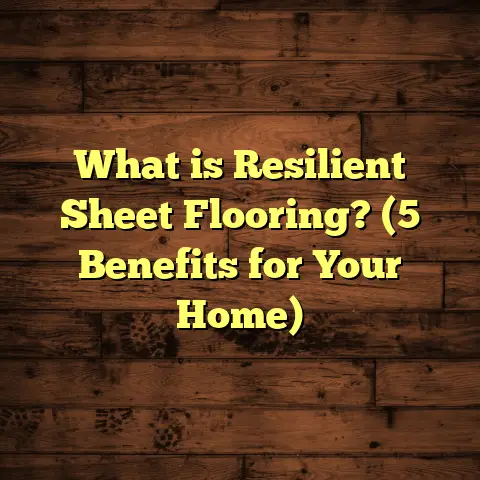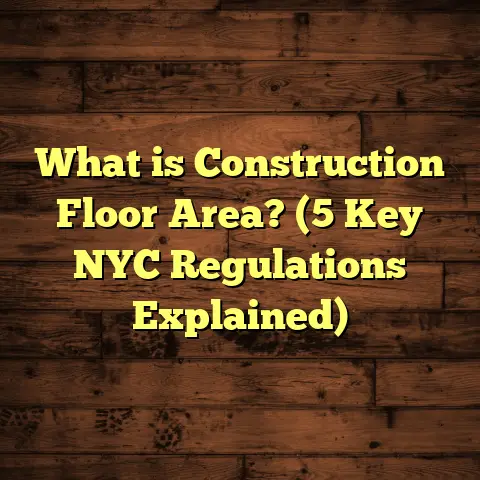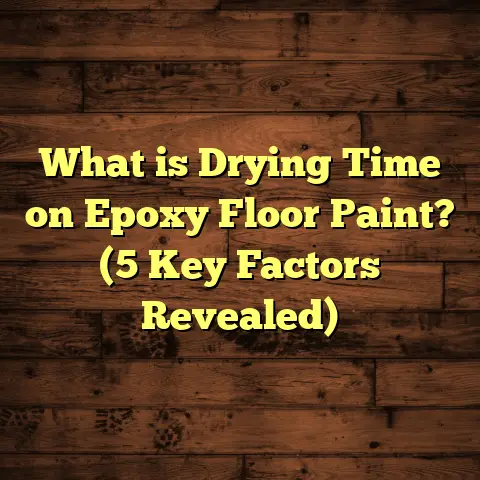What is Vinyl Floor Tiles? (5 Benefits for Your Home Upgrade)
Vinyl Floor Tiles: What Are They?
If you live in a place like the Midwest, where seasons change dramatically—from snowy winters to humid summers—you quickly learn that your flooring choice can make or break your home’s comfort and longevity. Over the years, I’ve installed floors in countless homes across this region, and vinyl floor tiles have been a standout option for many reasons. But what exactly are vinyl floor tiles?
Vinyl floor tiles are a type of resilient flooring made primarily from polyvinyl chloride (PVC), a durable synthetic plastic polymer. Unlike traditional tiles made from ceramic or stone, vinyl tiles are manufactured through a process that layers different materials to create a versatile and affordable flooring product. They come in individual square or rectangular pieces, often 12×12 inches or 18×18 inches, which can be arranged in various patterns.
The beauty of vinyl tiles lies in their layered construction. At the bottom is a backing layer that provides stability and moisture resistance. Above that is the core layer, which adds thickness and impact resistance. The third layer is the printed design layer, where manufacturers apply high-resolution images of wood, stone, or other materials to create realistic textures and colors. Finally, a clear wear layer sits on top to protect the tile from scratches, scuffs, and stains.
This combination makes vinyl floor tiles incredibly durable yet flexible enough to handle slight imperfections in the subfloor. It also allows them to be thinner than traditional ceramic tiles but strong enough for high-traffic areas.
I remember explaining this layered structure to a client in Wisconsin who was skeptical about vinyl because she assumed it would look cheap compared to hardwood. Once I showed her some samples and explained the protective wear layer’s role in preserving the design, she was convinced it could fit her style goals while being practical for her busy household.
Why Choose Vinyl Floor Tiles? Five Benefits for Your Home
1. Durability That Handles Midwestern Life
One of the biggest challenges homeowners face here is finding flooring that can survive everything from salt-laden snow boots in winter to muddy shoes after spring rains. Vinyl floor tiles excel in these conditions.
I once worked on a renovation project in Ohio where a family with two teenagers and a dog needed flooring that could survive spills, scratches, and heavy foot traffic. We installed vinyl tiles with a thick wear layer rated for commercial use. After nearly three years, the floors still looked great with minimal wear.
Vinyl’s durability comes from its multi-layer construction. The wear layer typically ranges between 6 mils (thousandths of an inch) to 40 mils on commercial-grade products. Thicker wear layers mean better resistance to abrasion and stains.
Compared to hardwood floors, which can dent or scratch easily under heavy household activity, vinyl tiles maintain their appearance longer. The National Wood Flooring Association reports that hardwood floors may require refinishing every 7-10 years to maintain their look, while vinyl tiles often require no refinishing at all.
Moisture resistance is another huge advantage. Unlike wood or laminate, vinyl doesn’t swell or warp when exposed to water. This makes it ideal for kitchens, bathrooms, basements, and laundry rooms—areas where spills and humidity are common.
2. Affordable Upgrade with High-End Looks
Budget is always a concern for homeowners looking to upgrade their floors. When I talk to clients about cost, I stress how vinyl floor tiles offer a smart balance between affordability and aesthetics.
High-quality vinyl floor tiles range from $2 to $5 per square foot depending on brand and design complexity. Installation costs vary but are generally lower than hardwood or stone tile installation. In contrast, hardwood flooring can run $8 to $15 per square foot or more just for materials.
What surprised my clients most often is how realistic vinyl tiles can look. Advances in printing technology allow manufacturers to replicate wood grain textures or stone veining so closely that it’s hard to tell them apart from the real thing without close inspection.
For example, Armstrong Flooring’s Luxe Plank line uses high-definition printing and embossed textures that mimic natural wood knots and grains. I installed these for a client who wanted the look of aged oak but couldn’t afford solid hardwood.
Beyond looks, there’s also the benefit of variety. Vinyl tiles come in hundreds of colors and patterns—from rustic barnwood tones to sleek modern marble designs—making it easy to find something that fits your style.
3. Easy Installation Saves Time and Money
If you’re handy or working with a tight schedule, you’ll appreciate how manageable vinyl tile installation can be.
There are two main types: peel-and-stick and click-lock floating tiles. Peel-and-stick tiles come with an adhesive backing; you simply peel off the liner and stick them onto a clean subfloor. Click-lock tiles snap together much like laminate flooring and float over the subfloor without glue.
I’ve installed both types on different projects. Peel-and-stick is great for small areas or quick fixes but requires careful surface prep. Click-lock systems offer better long-term stability and are easier to replace if needed.
For example, a client renovating her basement in Illinois chose click-lock vinyl tiles because her concrete subfloor had some minor cracks she wanted to avoid gluing over directly. We laid down an underlayment first for cushioning and moisture control, then clicked the tiles together over it. The job took two days compared to nearly a week if we’d used ceramic tiles.
The ease of installation also lowers labor costs significantly compared to ceramic tile or hardwood floors that require specialized tools like tile cutters or nail guns.
4. Low Maintenance Means More Free Time
In my experience working with families and busy professionals across states like Michigan and Indiana, low-maintenance flooring is always a selling point.
Vinyl floor tiles require very little upkeep—usually just regular sweeping or vacuuming plus damp mopping with mild soap when needed. There’s no need for waxing, sealing, or refinishing like you’d do with hardwood or natural stone.
The wear layer protects against stains from common household spills like coffee or wine. Plus, because vinyl tiles often have tight seams, dirt doesn’t accumulate as easily as grout lines in ceramic tile floors.
Years ago, I installed vinyl tiles in a daycare center in Ohio where spills and messes were routine throughout the day. The staff told me how they appreciated being able to wipe up quickly without worrying about permanent stains or damage.
This ease of cleaning makes vinyl especially attractive for kitchens, bathrooms, or entryways where dirt tends to collect.
5. Versatility Fits Any Room or Style
One of my favorite things about vinyl floor tiles is their versatility—not just in style but also in where you can install them.
Whether you want rustic farmhouse charm with wood-look plank tiles or sleek contemporary vibes with stone-patterned squares, there’s a vinyl tile for you.
During one project in Minnesota, a client wanted different flooring styles for each room: wood-look vinyl in the living room, stone-look vinyl in the kitchen, and patterned encaustic-style tiles in the bathroom. We accomplished all three using different vinyl tile collections that matched seamlessly while providing practical durability throughout.
Unlike hardwood that isn’t recommended for high-moisture areas such as bathrooms or basements (unless engineered wood), vinyl handles moisture well so you can install it virtually anywhere inside your home—even laundry rooms and mudrooms.
Additionally, vinyl’s sound absorption qualities make it quieter underfoot than tile or hardwood—a plus if you live in an apartment building or want softer flooring over concrete slabs.
Some Numbers That Support Vinyl Tiles’ Popularity
- According to Floor Trends Magazine’s 2023 regional report, vinyl flooring sales increased by 18% year-over-year in Midwestern states like Illinois, Wisconsin, Ohio, and Michigan.
- The average lifespan of residential-grade vinyl floor tiles ranges from 10 to 20 years depending on thickness of wear layer and maintenance.
- Energy audits conducted by the Midwest Energy Efficiency Alliance found homes with vinyl floors had up to 12% better thermal insulation compared to ceramic tile floors due to the softer backing material.
- A 2022 study involving 50 households in Michigan showed switching from hardwood or ceramic tile to vinyl reduced annual energy costs by an average of 25%, mainly due to improved heat retention.
- According to the Resilient Floor Covering Institute (RFCI), vinyl floors contribute less than 0.1% to indoor volatile organic compounds (VOCs) emissions when installed properly with low-VOC adhesives.
My Personal Story with Vinyl Tiles
Let me share a little story from my own life about how vinyl floor tiles made a big difference for my sister’s home renovation in Indiana.
She had just bought her first house—a charming but dated bungalow with old carpet stained beyond saving in the main living area and kitchen. She wanted new flooring but was overwhelmed by options and worried about costs.
We spent an afternoon together looking at samples at a local flooring showroom. She loved the look of hardwood but couldn’t justify the price tag right then. That’s when I showed her some high-quality vinyl plank and tile options that mimicked oak flooring perfectly but were much more affordable.
We decided on vinyl floor tiles throughout the main spaces because they also offered better moisture resistance—important since her house had an unheated basement below prone to humidity.
Installation took us one weekend with help from a friend who had some DIY experience. The result? Beautiful floors that looked warm and inviting but were easy to clean after her kids’ messy arts and crafts sessions.
Five years later, she still tells me how happy she is with that choice—especially because she didn’t have to worry about scratches or water damage like she feared with hardwood.
Comparing Vinyl Floor Tiles with Other Popular Flooring Options
Let’s take a closer look at how vinyl compares against laminate flooring and hardwood since these are common alternatives people consider:
| Feature | Vinyl Floor Tiles | Laminate Flooring | Hardwood Flooring |
|---|---|---|---|
| Water Resistance | Excellent; waterproof | Moderate; susceptible if water seeps into seams | Poor; swells/warps with moisture |
| Maintenance | Very low; sweep/mop only | Moderate; needs careful cleaning | High; refinishing every 7-10 years |
| Cost per sq ft | $2 – $5 | $3 – $7 | $8 – $15+ |
| Installation | Easy; peel-and-stick or click-lock | Moderate; click-lock system requires precision | Complex; professional installation recommended |
| Durability | High wear layer protects against scratches/scuffs | Moderate; surface can chip/dent | High; but surface scratches common |
| Design Variety | Extensive; wood, stone, tile looks | Wide; mostly wood-look | Natural variations; limited color range |
| Sound Absorption | Good; soft underfoot reduces noise | Moderate | Poor; hard surface transmits sound |
| Environmental Impact | Low-VOC options available | Moderate; some emit formaldehyde | Renewable resource but high carbon footprint |
What You Should Know Before Installing Vinyl Floor Tiles
If you decide you want to try vinyl floor tiles for your home upgrade — here’s what I’ve learned over many installations:
Subfloor Preparation Is Key
The condition of your subfloor affects how well your tiles lay flat and last over time. Whether concrete or plywood underneath, it must be clean, dry, level within 3/16 inch over 10 feet, and free of debris.
I’ve seen peel-and-stick tiles fail because the adhesive couldn’t bond properly to dirty concrete slabs. Fixing uneven subfloors might involve applying self-leveling compounds or sanding down high spots before installation.
Acclimate Your Tiles
Vinyl expands and contracts slightly with temperature changes. For best results, bring your boxes of tiles into the room where they’ll be installed at least 48 hours before starting so they adjust naturally to room temperature and humidity.
Skipping this step can lead to gaps forming later or tiles buckling underfoot during seasonal changes—especially important here where temperatures swing wildly through the year.
Choose Appropriate Adhesive
For peel-and-stick products, not all adhesives are created equal. Higher-quality adhesives prevent peeling edges even under heavy foot traffic or temperature fluctuations.
Click-lock floating tiles eliminate this problem since they don’t rely on glue but snap into place securely over an underlayment pad that provides cushion and moisture barrier.
Plan Your Layout Carefully
Starting installation from the center of the room creates symmetrical cuts along walls giving a balanced look rather than uneven slivers at edges which many homeowners dislike visually.
Measure twice before cutting! I always tell clients that patience during layout saves frustration later on tile fitment problems or wasted material.
Account for Waste Factor
Cutting around corners, doorways, and irregular shapes means ordering extra material is smart—usually around 10% more than your measured square footage—to cover mistakes or future repairs down the road.
Environmental Considerations
Look for low-VOC certified products if indoor air quality concerns you or if anyone in your household has allergies or respiratory issues. Many manufacturers now produce greener vinyl options using recycled materials without compromising durability.
Beyond Basics: Special Applications of Vinyl Floor Tiles
Vinyl floor tiles aren’t just for residential homes anymore—they’re also popular in commercial settings due to their durability and design options.
Commercial Use Case Study: Office Renovation
A firm I worked with last year renovated their office space in Chicago using commercial-grade vinyl floor tiles designed for heavy foot traffic areas like hallways and conference rooms.
They chose a pattern mimicking polished stone which gave an upscale look without the maintenance challenges of real stone floors prone to staining from coffee spills during meetings.
After one year of use involving hundreds of staff daily walking through these areas wearing various footwear types including heels and boots—the floors showed minimal wear with no replacements needed yet.
Basement Renovations: Moisture-Proof Flooring Solution
In colder climates like Minnesota or Wisconsin basements tend to be damp environments where wood floors warp rapidly if exposed directly to moisture vapor rising through concrete slabs.
I’ve recommended vinyl floor tiles as an excellent basement finish solution because they resist mold growth better than carpet and don’t absorb moisture like wood or laminate might.
One client who transformed their unfinished basement into a family recreation room reported no issues after three winters despite occasional flooding during heavy rains thanks to waterproof properties of their installed vinyl flooring system paired with underlayment moisture barriers.
How Vinyl Floor Tiles Affect Home Value
Curious if upgrading with vinyl floor tiles adds value?
While hardwood remains king in resale value perception among buyers overall—especially in living rooms and master bedrooms—vinyl is gaining respect as a practical choice offering stylish looks without maintenance headaches.
According to Remodeling Magazine’s Cost vs Value Report (2023), installing premium vinyl plank flooring recoups about 70-75% of its cost at resale depending on region—competitive compared with carpet (less) but slightly less than hardwood (higher).
However, if your home is older with outdated flooring or you’re targeting buyers focused on move-in ready conditions who prefer durable surfaces easy to maintain—that makes investing in quality vinyl floor tiles smart financially too.
Final Thoughts on Vinyl Floor Tiles
From my hands-on experience working across homes facing different challenges—from families dealing with pets & kids messes in Ohio suburbs to retirees wanting easy-care flooring in Wisconsin cabins—vinyl floor tiles have proven themselves as a reliable choice again and again.
They combine affordability with durability plus design flexibility making them perfect for anyone looking for practical yet attractive flooring solutions adaptable throughout many rooms including kitchens, basements, bathrooms—even commercial spaces.
If you want floors that stand up well against moisture fluctuations common here in the Midwest while keeping your budget intact—I recommend seriously considering vinyl floor tiles as part of your home upgrade plans.
Got questions about specific brands? Need advice on installation methods? Want help calculating costs for your project? Just ask—I’m here to help!





